Traditional Chinese Painting
The History of Chinese Painting
Chinese painting, commonly known as “dan qing/丹青” or “guo hua/国画” in Chinese (meaning the national painting), is mainly drawn on silk or paper and then framed in a scroll. It involves the use of a brush, ink, and paint. To draw a Chinese painting, a set of fixed rules and artistic forms are to be followed, which are passed down from generation to generation.
Chinese painting enjoys a time-honored history. Over the past thousands of years, with the accumulative and innovative efforts of painters and craftsmen, among whom the majority are the Han Chinese while the others are ethnic minorities, a unique Chinese painting system has been formed featuring rich art forms of various ethnic groups, exerting a profound influence on the Oriental art circle and even that of the world. The history of Chinese painting can be traced back to the primitive society of the Neolithic Age when colored pottery and rock paintings made their way into the daily life of ordinary people. The painting techniques found in these works were quite simple, yet demonstrated that the people back then had a basic mastery of portrait painting. They were able to reflect the striking features of the animals and plants to show their aspiration and wishes for a better life.
Deeply rooted in the cultural identity of the Chinese nation, Chinese painting constitutes a vital part of the traditional Chinese culture. It lays an equal emphasis on both the art form and the spirit of the painted object. The use of a writing brush, ink, and rice paper contributes to a unique theoretical system of Chinese painting. The drawings are not limited to time or space but call for imagination and simplicity. These unique painting techniques not only showcase the charm of Chinese painting but also enrich the world’s art treasury trove.
Chinese Painting and Its Culture
In terms of the theme and artistic form, Chinese painting embodies the ideology and aesthetic orientation of the Chinese nation. It is also a reflection of the Chinese people’s understanding of nature and society as well as the related politics, philosophy, religion, morality and art. The earliest Chinese painting can be found in the images painted on the rocks and potteries of primitive society, and in the Warring States Period, people drew images on silk. All these works are characterized by the use of simple lines, laying a foundation for the future development of painting techniques. During the Western and Eastern Han Dynasties and the Wei and Jin Dynasties, the theme of painting shifted to religion, while other paintings depicting historical figures and literary elements also accounted for a large proportion. Meanwhile, landscape paintings and bird and flower paintings were in their burgeoning phase. With all these new developments, a theoretical foundation based on which a painting was judged was also formed during this period. The Sui and Tang Dynasties witnessed the boom of Chinese painting. Landscape paintings, as well as bird and flower paintings, entered a mature stage of development, while religious paintings experienced their prime time and became more accessible to ordinary people. Back then, figure painting mainly depicted the daily life of the nobility and had its unique way of characterization. During the Five Dynasties and the Northern and Southern Song Dynasties, the focus of figure painting shifted to the daily life of ordinary people, while religious paintings started to decline. As a result, landscape painting and bird and flower painting became the mainstream of Chinese painting. Later, the emergence of humanistic paintings enriched the themes and drawing techniques of Chinese painting. During the Yuan, Ming, and Qing Dynasties, landscape paintings and bird and flower paintings excelled in other forms to become the mainstream of Chinese painting. The paintings of other styles were simply copied from one another, consequently withering away in people’s lives.
Initially, Chinese paintings were created for the appreciation of the nobility but as time elapsed, they gradually became accessible to the ordinary folk. Accordingly, the themes also witnessed a profound change. The painters started to focus on the reality of society and created a wealth of fine works that reflected the features of their age.
Chinese Painting, Aesthetics, and Philosophy
The theme, portrayal, and techniques of Chinese painting offer insights into traditional Chinese aesthetic standards and philosophy. When observing an object, painters would usually approach it from both micro and macro perspectives and regard themselves as participants rather than outsiders. So their perception would not be fixed on a certain perspective or simply focus on the exterior of the object. Usually, the paintings are subject to the ideological influence of the painters, and sometimes enlighten people on moral education. Though the objects can be landscapes, birds, or flowers, they are mingled with the perceptions of the painters when created on a piece of paper or silk. The paintings, therefore, are associated with the ideology and aesthetic orientation of the painters and embody the idea that man is an integral part of nature.
Where can I appreciate and learn Chinese painting during my trip to China?
Children and students accompanied by their parents can have a Chinese painting learning experience in most tourist cities. Beijing hutong, Shanghai Art Gallery, the ancient city of Xi'an, and the West Street of Yangshuo are all ideal places for you to have a glimpse of Chinese painting.
GREAT FAMILY CHINA TOUR
JULY 2024 We wanted to thank Grace at China Culture tour for organizing a great tour of China. We enjoyed our Beijing - Xian-Chengdu -Guilin -Yangshuo - Shanghai trip. Our local guides Bruce in Beijing, Susan in Xian, Jane in Chengdu, Mike in Guilin and Mary in Shanghai took care of us…read more details »
Teng Han L from SINGAPORE
Ready to Create a Unique Dream Travel?

